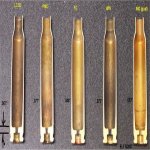Boolitcaster
CGN Regular
- Location
- Vancouver Island
Those look very nice. What are you drawing the jacket from?
They look amazing! Would love to see the process in how you made those.
Are you using brass with all the same headstamp?
Have you weighed your jackets and your cores to find out where the difference might come from?
I can see a slight difference in web thickness getting magnified if the brass is being drawn down in diameter.
If you then try to shove the same lead core size into two jackets with a different thickness of "bottom" then your tip forming will be uniform and weight will be off.
I have no experience with swaging just trying to help figure out where inconsistencies might come from.
I understand the total weight method you explain so the endresult after melting should be spot on weight wise
doing it this way.
If however you have used a jacket with a thicker bottom then that one has the same final weight but more volume since there is more brass and less lead than a bullet made with a thinner bottom.
Have you weighed jackets after the final swaging and trimming? How much weight difference do you see there?
That is a good question. I just weighed 10 jackets destined for the 200 grain bullets.
All matching headstamps and probably from the same lot#.
Weight in grains:
77.6, 77.5, 77.4, 78.3, 77.4, 77.4, 77.1, 77.6, 77.5, 77.9
The larger variances are almost certainly due to my error when cutting on the lathe. The lathe is very old and the vice slips from time to time. I have a squirt die for making exact weight cores, but I find it to be prone to clogging and in general operation, a pain in the a$$.
I am sure that there is much more variance in the lead cores.

Would be interesting to know the bottom/base thickness of the lighter and heavier ones to see if that is consistent or varies.
See below the thickness difference of Federal vs Winchester 223 brass.
If you were to swage them both down you are going to end up with a substantial base thickness difference.
By the way I have to say I think your bullets look great! Have you fired some and if so how do they perform?
View attachment 654251








































